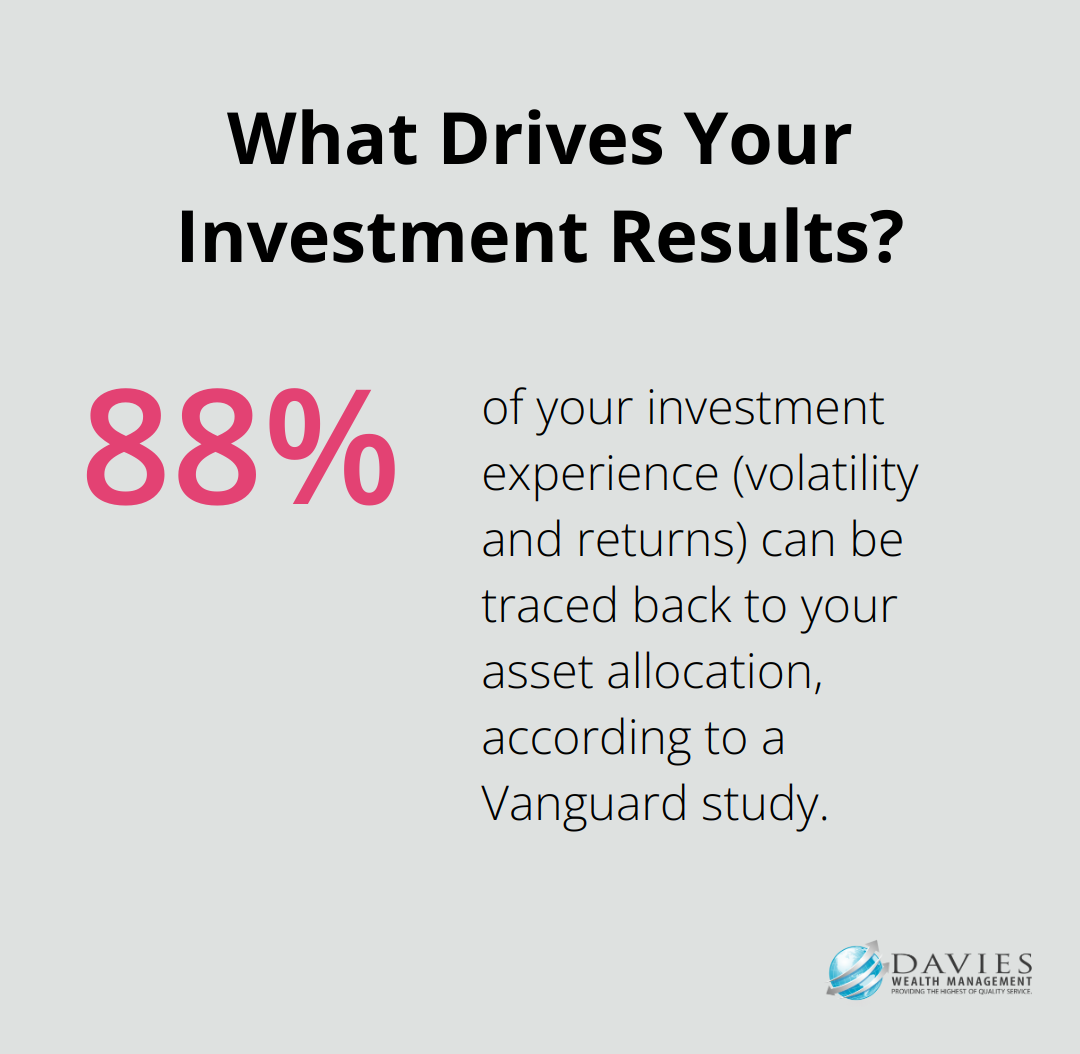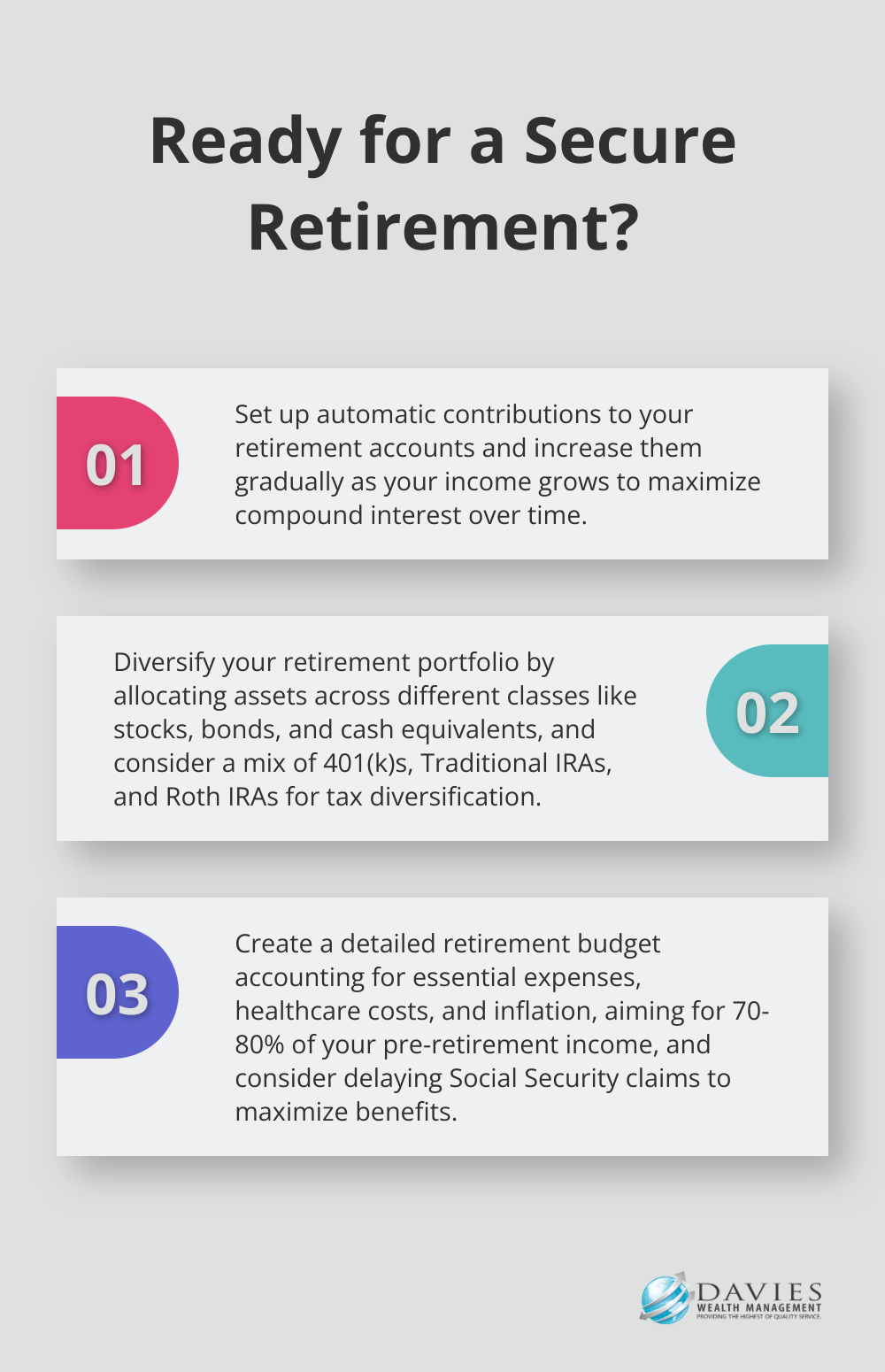Planning for retirement can be daunting, but at Davies Wealth Management, we believe in the principle of “safety first” when it comes to securing your financial future.
A well-structured retirement plan is essential for ensuring a comfortable and worry-free life after your working years. This blog post will guide you through key strategies for safety-first retirement planning, helping you build a secure financial foundation for your golden years.
Why Start Early for Retirement?
Starting early is one of the most powerful strategies for building a secure retirement. The impact of early planning on financial futures cannot be overstated.
The Magic of Compound Interest
Compound interest transforms retirement planning. It’s the process where your money earns returns, and those returns then earn additional returns. Over time, this snowball effect can lead to substantial growth in your retirement savings.

You can use a Compound Interest Calculator to determine how much your money can grow using the power of compound interest.
The Advantage of Your 20s and 30s
Beginning your retirement planning in your 20s or 30s provides a significant advantage. You have more time to weather market fluctuations and can afford to take on more risk for potentially higher returns.
Moreover, early planning allows you to contribute less money overall while still reaching your retirement goals. This leaves more of your income available for other financial priorities (such as buying a home or starting a family).
Strategies to Maximize Compound Interest
To harness the full power of compound interest, consider these strategies:
- Contribute consistently: Set up automatic contributions to your retirement accounts to ensure regular investments.
- Maximize employer matches: If your employer offers a 401(k) match, contribute at least enough to get the full match. It’s essentially free money for your retirement.
- Reinvest dividends: Instead of taking dividends as cash, reinvest them to purchase additional shares and accelerate your account growth.
- Increase contributions over time: As your income grows, gradually increase your retirement contributions. Even small increases can make a big difference over time.
- Choose appropriate investments: Work with a financial advisor to select investments that align with your risk tolerance and long-term goals. Using your risk tolerance to choose your retirement investing strategy is crucial.
The implementation of these strategies (and more) can significantly impact your retirement savings. Each individual’s situation and goals are unique, so a tailored approach is essential.
As we move forward, it’s important to consider how to diversify your retirement portfolio to further strengthen your financial future. A well-balanced investment strategy can help mitigate risks and maximize potential returns over the long term.
How to Build a Diverse Retirement Portfolio
Understanding Asset Allocation
Asset allocation forms the foundation of a robust retirement portfolio. It involves the distribution of investments across different asset classes, such as stocks, bonds, and cash equivalents. The primary objective is to optimize returns while managing risk. A study by Vanguard reveals that 88% of your experience (the volatility you encounter and the returns you earn) can be traced back to your asset allocation.
Exploring Retirement Account Options
Several types of retirement accounts offer distinct advantages:
401(k)s: These employer-sponsored plans often include matching contributions. It’s prudent to contribute at least enough to maximize this benefit (essentially free money for your retirement).

Traditional IRAs: These accounts offer tax-deductible contributions and tax-deferred growth. Taxes apply to withdrawals in retirement, potentially when you’re in a lower tax bracket.
Roth IRAs: Contributions are not tax-deductible, but earnings can grow tax-free, and qualified withdrawals are tax- and penalty-free.
For many investors, a combination of these accounts provides tax diversification and flexibility in retirement.
Balancing Risk and Reward
Your investment strategy should adapt as you approach retirement. Early in your career, you might allocate a larger portion of your portfolio to stocks for potential growth. As retirement nears, a gradual shift towards more conservative investments can help protect your wealth.
A common guideline suggests investing a fixed percentage (110 minus age of household head) of assets in stock and the rest in TIPS. However, this serves merely as a starting point. Your individual risk tolerance and financial goals should guide your specific allocation.
The Role of Professional Advice
Professional financial advisors use sophisticated risk assessment tools to help clients find the right balance. They also emphasize the importance of regular portfolio rebalancing to maintain your desired asset allocation as market conditions fluctuate.
Diversification doesn’t guarantee profits or protect against losses, but it can help manage risk and potentially improve returns over the long term. As you construct your retirement portfolio, professional advice ensures your strategy aligns with your unique financial situation and goals.
The next step in securing your financial future involves creating a comprehensive retirement plan. This plan will address not only your investment strategy but also your overall financial needs and goals for retirement.
How Much Will You Need in Retirement?
Estimating Retirement Expenses
The first step in retirement planning requires an estimation of your future expenses. While some costs may decrease in retirement, others might increase. According to recent data, retiree households spend an average of about $5,000 a month. However, this figure can vary widely based on lifestyle choices and location.

We recommend the creation of a detailed budget that accounts for essential expenses (housing, food, and healthcare), as well as discretionary spending (travel, hobbies, and entertainment). Many financial experts suggest trying for 70-80% of your pre-retirement income, but this can be higher or lower depending on your specific goals.
The Healthcare Cost Factor
Healthcare costs often receive underestimation in retirement planning. Fidelity’s 2022 estimate reveals that a 65-year-old couple can expect to spend $315,000 in health care expenses in retirement. This doesn’t include the potential need for long-term care, which can add significant costs.
Consider long-term care insurance as part of your retirement strategy. The American Association for Long-Term Care Insurance reports that more than half of people turning age 65 will require long-term care services at some point.
Inflation: The Silent Wealth Eroder
Inflation can significantly impact your retirement savings over time. Historically, inflation in the U.S. has averaged around 3% annually. This means that $100 today will only have the purchasing power of about $74 in 20 years.
To combat inflation, include investments that have the potential to outpace inflation in your retirement portfolio. This might include a mix of stocks, real estate investment trusts (REITs), and Treasury Inflation-Protected Securities (TIPS).
Maximizing Social Security Benefits
Social Security can form a substantial part of your retirement income. The age at which you start claiming benefits can significantly impact your lifetime payout. While you can start claiming at age 62, waiting until your full retirement age (66-67 for most people) or even up to age 70 can increase your monthly benefit by up to 8% per year.
Consider your health, family history of longevity, and other sources of income when deciding when to claim Social Security. For married couples, develop strategies to maximize combined benefits, which can be more complex but potentially more rewarding.
Personalized Retirement Planning
Each person’s retirement needs are unique. A personalized plan should account for all these factors and more. The goal is to build a retirement strategy that provides financial security and peace of mind for your golden years.
Final Thoughts
Safety-first retirement planning requires a comprehensive approach that prioritizes long-term financial stability. This strategy emphasizes the protection of assets while allowing for growth, carefully balancing risk and reward. Regular review and adjustment of your retirement strategy will help you adapt to changing market conditions, personal circumstances, and financial goals.

Every individual’s situation is unique, which makes professional financial advice invaluable in creating a personalized retirement plan. Seeking expert guidance can help you navigate complex financial decisions and ensure your retirement strategy aligns with your specific needs and objectives. As you progress through different life stages, your risk tolerance and financial needs may shift, necessitating modifications to your investment approach and overall plan.
At Davies Wealth Management, we specialize in helping individuals, families, and businesses (including professional athletes) achieve their financial objectives through comprehensive wealth management solutions. Our team is committed to providing clear, actionable solutions that align with your goals and ensure your financial security throughout retirement and beyond. We invite you to contact us to discuss how we can assist you in creating a robust, safety-first retirement plan tailored to your unique circumstances.



Leave a Reply